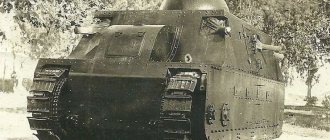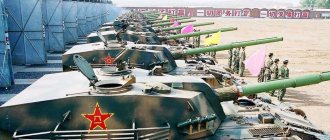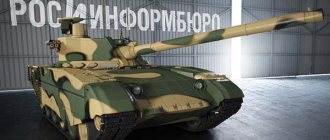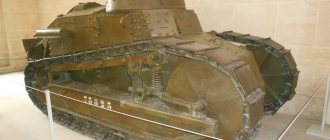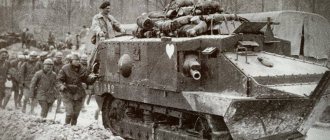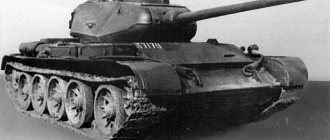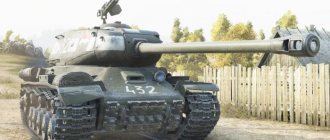Captured armored vehicles of the Wehrmacht. France
By May 1940, the French army had 2,637 tanks of the new type. These include: 314 B1 tanks, 210 - D1 and D2, 1070 - R35, AMR, AMC, 308 - H35, 243 - S35, 392 - H38, H39, R40 and 90 FCM tanks. In addition, up to 2,000 old FT17/18 combat vehicles (of which 800 were combat-ready) from the First World War period and six heavy 2Cs were stored in the parks. 600 armored vehicles and 3,500 armored personnel carriers and tracked tractors complemented the armored armament of the ground forces. Almost all of this equipment, both damaged during the fighting and absolutely serviceable, fell into the hands of the Germans. We can safely say that never before has any army in the world captured as much military equipment and ammunition as the Wehrmacht did during the French campaign. History knows no example of captured weapons being adopted in such large quantities by a victorious army. The case is undoubtedly unique! All this also applies to French tanks, the exact number of which is not even given by German sources.
Repaired and repainted in German camouflage, with crosses on the sides, they fought in the ranks of the enemy army right up to 1945. Only a small number of them, who were in Africa, as well as in France itself in 1944, were able to once again stand under the French banner. The fate of combat vehicles forced to operate “under a false flag” turned out differently.
Some tanks captured in good working order were used by the Germans during the fighting in France. After the completion of the “French campaign”, the bulk of the armored vehicles began to be transported to specially created parks, where they underwent a “technical inspection” in order to identify malfunctions. Then the equipment was sent for repair or re-equipment to French factories, and from there it went to German military units.
However, in the winter of 1941, things did not go further than the formation of four regiments and the headquarters of two brigades. It soon became clear that units armed with French armored vehicles could not be used in accordance with the tactics of the Wehrmacht tank forces. And mainly due to the technical imperfections of captured combat vehicles. As a result, already at the end of 1941, all regiments that had French tanks were re-equipped with German and Czechoslovak combat vehicles. The released captured equipment was used to equip numerous individual units and subunits that primarily performed security service in the occupied territories, including SS units and armored trains. The geography of their service was quite extensive: from the islands in the English Channel in the west to Russia in the east and from Norway in the north to Crete in the south. - A significant part of the combat vehicles were converted into various kinds of self-propelled guns, tractors and special vehicles.
The nature of the use of captured vehicles was most directly influenced by their tactical and technical characteristics. Only the H35/39 and S35 were supposed to be used directly as tanks. Apparently, the decisive factor was their higher speed than other machines. According to the original plans, they were supposed to staff four tank divisions.
After the end of hostilities in France, all serviceable and faulty R35 tanks were sent to the Renault plant in Paris, where they underwent inspection or restoration. Due to its low speed, the R35 could not be used as a battle tank, and the Germans subsequently sent about 100 vehicles for security duty. 25 of them took part in battles with Yugoslav partisans. Most of the tanks were equipped with German radio stations. The domed commander's cupola was replaced with a flat double-leaf hatch.
Captured French Renault R35 tanks were initially used by the Wehrmacht in their original form, without any changes, with the exception of new colors and markings
The Germans transferred part of the R35 to their allies: 109 to Italy and 40 to Bulgaria. In December 1940, the Berlin company Alkett received an order to convert 200 R35 tanks into self-propelled guns armed with a Czech 47-mm anti-tank gun. A similar self-propelled gun on the chassis of the German Pz.l tank was used as a prototype. At the beginning of February 1941, the first self-propelled gun based on the R35 left the factory floor. The gun was installed in a wheelhouse open at the top, located on the site of the dismantled turret. The frontal sheet of the cabin had a thickness of 25 mm, and the side sheets were 20 mm thick. The vertical pointing angle of the gun ranged from -8° to +12°, and the horizontal angle was 35°. A German radio station was located in the aft niche of the cabin. The crew consisted of three people. Combat weight - 10.9 tons. On a trial basis, one self-propelled gun of this type in 1941 was armed with a German 50-mm Pak 38 anti-tank gun.
Running in tanks. A captured Renault R35 with a double-leaf hatch instead of a French-style domed turret and a German radio station during training sessions with recruits in France
Light tank 35R 731(f) from the 12th Special Purpose Tank Company. This company, numbering 25 tanks, conducted counter-guerrilla operations in the Balkans. To increase cross-country ability, all vehicles were equipped with “tails”
Of the 200 ordered vehicles, 174 were manufactured as self-propelled guns, and 26 as command vehicles. The latter did not have a cannon installed, and there was no embrasure in the front deck of the cabin. Instead of a cannon, an MG34 machine gun was mounted in a Kugelblende 30 ball mount.
The remaining R35 tanks, after the turrets were dismantled, served in the Wehrmacht as artillery tractors for 150 mm howitzers and 210 mm mortars. The towers were installed on the Atlantic Wall as fixed firing points.
Captured German tank 35R 731(f) during testing at the NIBT Test Site in Kubinka near Moscow. 1945
German self-propelled artillery mount with a 47-mm Czechoslovak anti-tank gun on the chassis of a French R35 tank
As mentioned above, the Hotchkiss H35 and H39 tanks (in the Wehrmacht they were designated 35Н and 38Н) were used by the Germans as... tanks. They also had double-leaf tower hatches mounted on them and German radios were installed. The vehicles converted in this way entered service with the German occupation units in Norway, Crete and Lapland. In addition, they were intermediate weapons in the formation of new Wehrmacht tank divisions, for example, the 6th, 7th and 10th. As of May 31, 1943, the Wehrmacht, Luftwaffe, SS troops and others operated 355 35N and 38N tanks.
15 vehicles of this type were transferred to Hungary in 1943, and another 19, in 1944, to Bulgaria. Croatia received several 38N.
In 1943-1944, 60 Hotchkiss tank chassis were converted into a 75-mm self-propelled anti-tank gun. Instead of the removed turret, an impressively sized open-top conning tower was mounted on the tank’s hull, in which a 75-mm Pak 40 cannon was installed. The thickness of the front conning armor plates was 20 mm, and the side armor plates were 10 mm. With a crew of four people, the combat weight of the vehicles was 12.5 tons. The conversion of tanks into self-propelled guns was carried out by the Baukommando Becker enterprise (apparently an army repair plant).
At the same enterprise, 48 Hotchkisses were converted into self-propelled guns armed with a 105-mm howitzer. Externally, it was similar to the previous vehicle, but its wheelhouse housed a 105-mm leFH 18/40 howitzer. The vertical gun pointing angles ranged from -2° to +22°. The crew consisted of five people. 12 self-propelled guns of this type entered service with the 200th assault gun division.
Some of the captured R35 tanks were converted into artillery and evacuation tractors. Noteworthy is the military alteration - the driver's cabin
French tanks R35, H35 and FT17 in one of the German fleets of captured vehicles. France, 1940
Captured tank 38H(f) from one of the Luftwaffe units. The vehicle is armed with a 37-mm SA18 cannon, equipped with a “tail” and a radio station
Tanks 38H(f) of the 2nd battalion of the 202nd tank regiment during training sessions in France. 1941 On all vehicles, the domed commander's cupolas were replaced with hatches with double-leaf covers, and German radio stations were installed
For units armed with self-propelled guns based on Hotchkiss tanks, 24 tanks were converted into forward artillery observer vehicles, the so-called grosser Funk-und Befehlspanzer 38H(f). A small number of 38N were used for training purposes, as tractors, ammunition carriers and ARVs. It is interesting to note an attempt to enhance the tank's firepower by installing four launch frames for 280- and 320-mm rockets. On the initiative of the 205th Tank Battalion (Pz. Abt. 205), 11 tanks were equipped in this way.
After the rearmament of the 201-204 tank regiments with German armored vehicles, captured French tanks carried out security service in almost all theaters of military operations. These two Hotchkiss H39 tanks were photographed on a snowy road in Russia. March 1942
Captured German tank 38H(f) at the NIBT Test Site in Kubinka. 1945 Noteworthy is the fact that this car is covered with “zimmerit”
Due to their small numbers, FCM36 tanks were not used for their intended purpose by the Wehrmacht. 48 vehicles were converted into self-propelled artillery units: 24 with a 75 mm Rak 40 anti-tank gun, the rest with a 105 mm leFH 16 howitzer. All self-propelled guns were manufactured at Baukommando Becker. Eight anti-tank self-propelled guns, as well as several 105-mm self-propelled howitzers, entered service with the 200th assault gun battalion, included in the 21st tank division. The so-called Fast Brigade “West” - Schnellen Brigade West - also received some of the self-propelled guns.
Light tank 38H(f) during training sessions in one of the Wehrmacht units in Norway. 1942
Captured French tank 38H(f) during one of the counter-guerrilla operations in the mountains of Yugoslavia. 1943
A 38H(f) tank runs into a smoke grenade during training sessions. The 211th Tank Battalion, which included this vehicle, was stationed in Finland in 1941-1945
The few D2 medium tanks they received were also not used at all by the Germans. It is only known that their turrets were installed on Croatian armored trains.
As for the SOMUA medium tanks, most of the 297 units captured by the Germans under the designation Pz.Kpfw.35S 739(f) were included in the Wehrmacht tank units. SOMUA underwent some modernization: German Fu 5 radios were installed on them and the commander's cupola was retrofitted with a double-leaf hatch (but not all vehicles underwent such modifications). In addition, a fourth crew member, a radio operator, was added, and the loader moved to the turret, where there were now two people. These tanks were supplied mainly to man tank regiments (100, 201, 202, 203, 204 Panzer-Regiment) and individual tank battalions (202, 205, 206, 211, 212, 213, 214, 223 Panzer-Abteilung). Most of these units were stationed in France and served as reserves for replenishing Wehrmacht tank units.
For example, at the beginning of 1943, on the basis of the 100th tank regiment (armed mainly with S35 tanks), the 21st tank division was again formed, which was completely destroyed at Stalingrad by units of the Red Army. The revived division was stationed in Normandy, and in June 1944, after the Allied landings in France, it took an active part in the battles.
In the 205th Tank Battalion, 11 38H(f) tanks were equipped with launch frames for 280- and 320-mm rockets. The photo on the left shows the moment of the shot
Each 38H(f) tank was equipped with four launch frames. The photo shows how the sergeant-major screws the fuse into the rocket shell
As of July 1, 1943, there were 144 SOMUA in active Wehrmacht units (not counting warehouses and parks): in Army Group Center - 2, in Yugoslavia - 43, in France - 67, in Norway - 16 (as part of 211- th tank battalion), in Finland - 16 (as part of the 214th tank battalion). On March 26, 1945, German tank units still had five 35S tanks operating against Anglo-American troops on the Western Front.
It should be noted that the Germans used a number of SOMUA tanks to fight partisans and protect rear facilities, 60 units were converted into artillery tractors (the turret and upper front part of the hull were removed from them), and 15 vehicles entered service with armored trains No. 26, 27, 28, 29 and 30. Structurally, these armored trains consisted of a semi-armored steam locomotive, two open-top armored platforms for infantry and three special platforms with ramps for S35 tanks.
An American soldier inspects a captured 38H(f) tank. 1944
Forward artillery observer vehicle based on 38H(f)
105-mm self-propelled howitzer leFH 18 on the chassis of a light tank 38H(f)
Self-propelled artillery unit Marder I, armed with a 75-mm anti-tank gun Pak 40
Marder I on the Eastern Front. Eve of Operation Citadel, June 1943
Tanks of armored train No. 28 took part in the assault on the Brest Fortress, for which they had to leave their platforms. On June 23, 1941, one of these vehicles was hit by hand grenades at the Northern Gate of the fortress, and another S35 was damaged by fire from an anti-aircraft gun there. The third tank broke through into the central courtyard of the citadel, where it was shot down by artillerymen of the 333rd Infantry Regiment. The Germans managed to evacuate two cars immediately. After repairs, they again participated in battles. In particular, on June 27, the Germans used one of them against the Eastern Fort. The tank fired at the embrasures of the fort, as a result, as stated in the report of the headquarters of the 45th German Infantry Division, the Russians began to behave more quietly, but the continuous shooting of snipers continued from the most unexpected places.
As part of the mentioned armored trains, S35 tanks were used until 1943, when they were replaced by Czechoslovakian Pz.38(t).
Field Marshal E. Rommel (far left) inspects a unit of Marder I self-propelled anti-tank guns. France, 1944.
Self-propelled guns with a 75-mm cannon based on the FCM(f) tank in the factory workshop
After the occupation of France, the Germans repaired and returned to service 161 heavy tanks B1 bis, which received the designation Pz.Kpfw in the Wehrmacht. B2 740(f). Most of the vehicles retained standard armament, but installed German radios, and the commander's cupola was replaced with a simple hatch with a double-leaf lid. Turrets were removed from several tanks and all weapons were dismantled. In this form they were used to train driver mechanics.
In March 1941, the Rheinmetall-Borsig company in Düsseldorf converted 16 combat vehicles into self-propelled units, mounting an armored cabin open at the top and rear with a 105-mm leFH 18 howitzer in place of the previous armament and turret.
105-mm self-propelled howitzer based on the captured French FCM tank.
The internal volume of the armored cabin open at the top. Ammunition placement is clearly visible
On the basis of French heavy tanks, the Germans created a large number of flamethrower combat vehicles. At a meeting with Hitler on May 26, 1941, the possibility of arming captured B2 tanks with flamethrowers was discussed. The Fuhrer ordered the formation of two companies equipped with such machines. The first 24 B2s were equipped with flamethrowers of the same system as on the German Pz.ll (F), which operated on compressed nitrogen. The flamethrower was located inside the hull, in place of the removed 75-mm cannon. All tanks were sent to the 10th battalion, formed by June 20, 1941. It consisted of two companies, each of which, in addition to 12 flamethrower vehicles, had three support tanks (linear B2, armed with a 75-mm cannon). The 102nd battalion arrived on the Eastern Front on June 23 and was subordinated to the headquarters of the 17th Army, whose divisions stormed the Przemysl fortified area.
The first S35 tanks prepared for service in the Wehrmacht. The tanks are painted gray and equipped with Notek radios and headlights. On the starboard side there are characteristically shaped ammunition boxes
A column of 35S(f) tanks from one of the Wehrmacht units passes under the Arc de Triomphe in Paris. 1941
Tank 35S(f) from the 204th German Tank Regiment. Crimea, 1942
A 35S(f) tank captured by the Red Army at an exhibition of captured equipment at the Gorky Central Park of Culture and Culture in Moscow. July 1943
German armored train No. 28 (Panzerzug Nr.28). Eastern Front, summer 1941. This armored train included three special platforms (Panzertragerwagen) with S35 tanks. In the photo above you can clearly see the mounting points of the tank on the platform. The folding ramp, with the help of which the tank could descend to the ground, is laid on a ballast platform. Behind the platform with the tank, an infantry platform covered with a tarpaulin is visible.
The same thing, but without the tarpaulin
On June 24, 1941, the battalion supported the advance of the 24th Infantry Division. On June 26, the attacks were continued, but this time in conjunction with the 296th Infantry Division. On June 29, the assault on Soviet pillboxes began with the participation of flamethrower tanks. The report of the commander of the 2nd battalion of the 520th infantry regiment allows us to restore the picture of the battle. On the evening of June 28, the 102nd battalion of flamethrower tanks reached the indicated starting positions. At the sound of tank engines, the enemy opened fire from cannons and machine guns, but there were no casualties. With a delay caused by thick fog, at 5.55 on June 29, 8.8 cm Flak opened direct fire at the embrasures of the pillboxes. The anti-aircraft gunners fired until 7.04, when most of the embrasures were hit and fell silent. Following the green rocket, the 102nd Flamethrower Tank Battalion went on the attack at 7.05. Engineering units accompanied the tanks. Their task was to place high-explosive charges under the enemy’s defensive fortifications. When some pillboxes opened fire, the sappers were forced to take cover in an anti-tank ditch. 88-mm anti-aircraft guns and other types of heavy weapons returned fire. The sappers were able to reach their designated targets, plant and detonate high-explosive charges. The pillboxes were heavily damaged by 88mm gun fire and fired only periodically. The flamethrower tanks were able to approach the pillboxes almost closely, but the defenders of the fortifications put up desperate resistance, knocking out two of them with a 76-mm cannon. Both cars burned out, but the crews managed to abandon them. The flamethrower tanks were never able to hit the pillboxes, since the flammable mixture could not penetrate inside through the ball mounts. The defenders of the fortifications continued to fire.
Tank S35 on the platform of armored train No. 28. The armored cover of the tank's chassis is clearly visible
Tank 35S(f) of the commander of the 2nd company of the 214th tank battalion. Norway, 1942
A command tank equipped with a second radio station (its loop antenna is mounted on the roof of the MTO). Instead of a gun, a wooden model of it was installed. France, 1941
A 35S(f) medium tank painted white from the 211th German Tank Battalion. The identification mark for the vehicles of this battalion was a colored stripe painted along the perimeter of the turret.
Tank 35S(f) from the 100th Tank Regiment in Normandy. 1944
35S(f) 6th company of the 100th tank regiment of the 21st tank division. Normandy, 1944. By the time the Allies landed, the rearmament of the regiment with Pz.IV tanks had not yet been completed, so captured French tanks also went into battle
On June 30, the 102nd battalion was transferred to the direct subordination of the headquarters of the 17th Army, and on July 27 it was disbanded.
Further development of German tank flamethrowers took place using the same Pz.B2. For new types of weapons, a pump powered by a J10 engine was used. These flamethrowers had a firing range of up to 45 m, and the fuel supply allowed them to fire 200 shots. They were installed in the same place - in the building. The tank with the combustible mixture was located on the rear of the armor. They developed a scheme for improving the armor of the tank, they developed a flamethrower, and they carried out the final assembly.
Training sessions with captured French Blbis tanks in the 100th reserve tank battalion of the Wehrmacht. France, 1941 (right). One of the B2(f) tanks of the 213th Tank Battalion. 1944 The combat vehicles of this unit, stationed in the Channel Islands, met the end of World War II without ever seeing combat.
It was planned to convert ten B2 tanks in this way in December 1941 and the next ten in January 1942. In reality, the production of flamethrower vehicles proceeded much more slowly: although five units were ready in November, only three were produced in December, three more in March 1942, two in April, three in May, and finally in June - the last four. The further progress of the work is unknown, since the order for the rework was sent to French enterprises.
In total, about 60 B2(FI) flamethrower tanks were produced in 1941-1942. Together with other B2s, they were in service with quite a few units of the German army. So, for example, as of May 31, 1943, the 223rd tank battalion had 16 B2s (12 of them were flamethrowers); in the 100th Tank Brigade - 34 (24); in the 213th tank battalion - 36 (10); in the SS mountain rifle division "Prince Eugene" - 17 B2 and B2 (FI).
B2s were used in the Wehrmacht until the end of the war, especially in troops located in France. In February 1945, there were still about 40 such tanks here.
Serial flamethrower tank B2(F1) from the 213th tank battalion. The flamethrower installation and the flamethrower's viewing device are clearly visible
Flamethrower tank B2(F1) in battle. The firing range of the flamethrower reached 45 m
As for French tanks of other brands, they were practically not used by the Wehrmacht, although many of them received German designations. The only exception is, perhaps, the light reconnaissance tank AMR 35ZT. Some of these vehicles, which had no combat value, were converted into self-propelled mortars in 1943-1944. The turret was dismantled from the tank, and in its place a box-shaped conning tower, open at the top and rear, welded from 10 mm armor plates, was built. An 81-mm Granatwerfer 34 mortar was installed in the wheelhouse. The vehicle had a crew of four people and a combat weight of 9 tons.
A story about the use of captured French tanks in the Wehrmacht would be incomplete without mentioning the FT17/18. As a result of the 1940 campaign, the Germans captured 704 Renault FT tanks, of which only about 500 were in working order. Some of the vehicles were repaired and redesignated Pz.Kpfw. 17R 730 (f) or 18R 730 (f) (tanks with a cast turret) were used for patrol and security service. Renaults were also used to train driver mechanics of German units in France. Some of the disarmed vehicles were used as mobile command and observation posts. In April 1941, a hundred Renault FTs with 37 mm guns were allocated to reinforce armored trains. They were attached to railway platforms, thus obtaining additional armored cars. These armored trains patrolled the roads along the English Channel coast. In June 1941, a number of armored trains with Renault were allocated to fight partisans in the occupied territories. Five tanks on railway platforms were used to protect roads in Serbia. Several Renaults were also used in Norway for the same purposes. Captured Renaults and the Luftwaffe were constantly in use, which used them (about 100 in total) to guard airfields, as well as to clear runways. To do this, bulldozer blades were installed on several tanks without turrets.
80-mm self-propelled mortar based on the AMR 34ZT(f) light tank
In 1941, 20 Renault FT turrets with 37 mm guns were installed on concrete bases on the English Channel coast.
After the defeat of France, a significant number of French armored vehicles also fell into the hands of the Germans. However, most of them were outdated designs and did not meet the requirements of the Wehrmacht. The Germans hastened to get rid of such vehicles and handed them over to their allies. As a result, only one type of French armored car was used in the German army - the AMD Panhard 178.
More than 200 of these vehicles are designated Pz.Spah. 204(f) went to field troops and SS units, and 43 were converted into armored tires. The latter were equipped with a German radio station with a frame-type antenna. On June 22, 1941, there were 190 Panzers on the Eastern Front, 107 of which were lost by the end of the year. As of June 1943, the Wehrmacht still had 30 vehicles on the Eastern Front and 33 on the Western Front. In addition, by this time some of the armored cars had been transferred to security divisions.
The Vichy French government received permission from the Germans to retain a small number of armored vehicles of this type, but at the same time they demanded that the standard 25 mm guns be dismantled. In November 1942, during the Nazi invasion of the “free” zone (the unoccupied south of France), these vehicles were captured and used for police functions, and in 1943 the Germans armed some of the Panhards that did not have turrets with a 50-mm tank gun.
A group of captured French FT17 tanks from one of the Luftwaffe units. These outdated combat vehicles, which had limited mobility, were nevertheless successfully used to protect rear airfields
Some of the FT17 tanks were used by the Germans as fixed firing points - a kind of bunkers. This tank is installed at a checkpoint at a crossroads near Dieppe in 1943. In the foreground is a German soldier near a captured French machine gun Hotchkiss mod. 1914 (in the Wehrmacht - sMG 257(f)
The Germans also actively used a significant fleet of French artillery tractors and armored personnel carriers, which included both wheeled and tracked, and half-tracked vehicles. And if the Citroen P19 half-track vehicles were used in the West brigade without any major alterations, then many other types of equipment underwent significant changes.
For example, the Germans used French all-wheel drive two- and three-axle specialized army trucks Laffly V15 and W15. These vehicles were used in various parts of the Wehrmacht, mostly in pristine condition. However, in the West brigade, 24 W15T trucks were converted into mobile radio stations, and several vehicles were equipped with armored hulls, turning them into wheeled armored personnel carriers.
Since 1941, the German troops stationed in France have used the captured Unic half-track tractor as an artillery tractor for 75 mm anti-tank guns, 105 mm light field howitzers and mortars, a transporter for transporting personnel, an ambulance and a radio vehicle, and a carrier of ammunition and equipment. P107 - leichter Zugkraftwagen U304(f). There were more than a hundred such vehicles in the West brigade alone. In 1943, a number of them were equipped with an armored hull with an open top body (for this the chassis frame had to be lengthened by 350 mm) and reclassified into armored personnel carriers - leichter Schutzenpanzerwagen U304 (f), similar in size to the German Sd.Kfz.250. At the same time, some of the machines had open, and some had closed bodies. Several armored personnel carriers were armed with a 37-mm Rak 36 anti-tank gun with a standard shield.
Panhard AMD178 armored car in the 39th Anti-Tank Division of the 3rd German Panzer Division. Summer 1940. For unknown reasons, the vehicle does not have a turret; two MG34 machine guns are used as weapons.
Captured Pan-hard 178(f) armored vehicles were also used in police forces in the occupied territories. An armored vehicle during “restoring order” in a Russian village
Panhard 178(f) armored vehicle, equipped with a new, open top turret with a 50 mm KwK L42 cannon. 1943
A number of tractors were converted into semi-armored SPAAGs, armed with a 20-mm Rak 38 anti-aircraft gun. In an even larger series (72 units), Baukommando Becker produced armored SPAAGs with similar weapons. These vehicles also entered service with the West brigade.
The heavier half-track tractors SOMUA MCL - Zugkraftwagen S303(f) and SOMUA MCG - Zugkraftwagen S307(f) were used as artillery tractors. Some of them were also equipped with an armored hull in 1943. At the same time, they were supposed to be used both as armored tractors - mittlerer gepanzerter Zugkraftwagen S303(f), and as armored personnel carriers - mittlerer Schutzenpanzerwagen S307(f). In addition, combat vehicles were created on their basis: m SPW S307(f) mit Reihenwerfer - self-propelled multi-barreled mortar (36 units manufactured); in the rear of the vehicle, a double-row package of 16 barrels of French 81-mm mortars was mounted on a special frame; 7.5 cm Cancer 40 auf m SPW S307(f) - self-propelled 75 mm anti-tank gun (72 units manufactured); armored ammunition carrier (48 units manufactured); an engineering vehicle equipped with special bridges to overcome ditches; 8 cm Raketenwerfer auf m.gep.Zgkw. S303(f) - a rocket launcher with a package of guides for launching 48 rockets, copied from the Soviet 82-mm launcher BM-8-24 (6 units manufactured); 8-cm schwerer Reihenwerfer auf m.gep Zgkw. S303(f) - self-propelled multi-barreled mortar (16 units manufactured) with a package of 20 barrels of captured French Granatwerfer 278(f) mortars.
Radio vehicle based on Panhard 178(f) from the 1st SS Panzer Division "Leibstandarte Adolf Hitler". Instead of a turret, the vehicle is equipped with a fixed wheelhouse, in the front of which an MG34 machine gun is installed.
Panhard 178(f) armored trolley. Vehicles of this type were attached to armored trains and were intended for reconnaissance. Like German armored cars, the captured French armored car is equipped with a frame antenna, the mounting method of which did not interfere with the circular rotation of the turret
All of these combat vehicles were used by the Wehrmacht and SS troops during the fighting in France in 1944.
Of the purely tracked French combat vehicles captured and widely used by the Germans, the first to be mentioned is the multi-purpose transporter Renault UE (Infanterieschlepper UE 630(f). Initially, it was used as a light tractor for transporting equipment and ammunition (including on the Eastern Front ) With an armored cabin and armed with a UE 630(f) machine gun, it was used for police and security functions.In Luftwaffe units, several vehicles were equipped with one or even two cabins with MG34 machine guns and were used to guard airfields, several hundred were converted into anti-tank installations for infantry parts - 3.7 cm Cancer 36(Sf) auf Infanterieschlepper UE 630(f). At the same time, the upper machine and the gun shield remained unchanged. Another 40 transporters were equipped with a special armored cabin located in the rear part, where the radio station was located. They were used in as communication and surveillance vehicles in units armed with captured French tanks.Several tractors were converted into cable layers. In 1943, almost all vehicles that had not previously undergone modifications were equipped with launchers of heavy rocket mines - 28/32 cm Wurfrahmen (Sf) auf Infanterieschlepper UE 630 (f).
Wheeled armored personnel carriers manufactured in the West brigade based on the French Laffly W15T all-wheel drive trucks. On the left - with the second axle removed, on the right - on the original chassis
Light armored personnel carriers U304(f). At the top is a headquarters armored personnel carrier with two radio stations, at the bottom is the company commander’s vehicle, armed with a 37-mm Pak 36 anti-tank gun and an MG34 machine gun on an anti-aircraft mount
Armored personnel carrier U304(f) on the way to the front line. Normandy, 1944
Self-propelled anti-aircraft gun based on U304(f), armed with a 20-mm Flak 38 automatic anti-aircraft gun. The vehicle tows a trailer with ammunition
A battery of semi-armored self-propelled guns on the U304(f) chassis during a combat training mission. France, 1943
Combat vehicles based on the Somua S307(f) artillery tractor: 75 mm self-propelled anti-tank gun
16-barreled self-propelled mortar
Self-propelled launcher on the S303(f) tractor chassis - 8-cm-Raketenwerfer. These vehicles were manufactured by order of the SS troops
At first, the 300 captured Lorraine 37L tracked armored personnel carriers were not very actively used by the Wehrmacht. An attempt to use them for transporting various cargoes was not very successful: with a mass of 6 tons, the tractor’s carrying capacity was only 800 kg. Therefore, already in 1940, the first attempts were made to convert these vehicles into self-propelled guns: 47-mm French anti-tank guns were mounted on several tractors. Mass conversion of tractors into self-propelled units began in 1942. Three types of self-propelled guns were manufactured on the Lorraine 37L chassis: 7.5 cm Rak 40/1 auf Lorraine Schlepper(f) Marder I (Sd.Kfz.135) - self-propelled 75-mm anti-tank gun (179 units manufactured); 15 cm sFH 13/1 auf Lorraine Schlepper(f) (Sd.Kfz. 135/1) - self-propelled 150 mm howitzer (94 units manufactured); 10.5 cm leFH 18/4 auf Lorraine Schlepper(f) - 105 mm self-propelled howitzer (12 units produced).
All of these self-propelled guns were structurally and externally similar to each other and differed from each other mainly only in the artillery system, which was located in a box-shaped conning tower located at the rear of the vehicle, open at the top.
Self-propelled guns on the Lorraine chassis were also used by the Germans on the Eastern Front and North Africa, and in 1944 in France. One of the German armored trains included a self-propelled gun on the Lorraine Schlepper(f) chassis, in which the Soviet 122-mm MZO howitzer was installed in the standard wheelhouse.
Based on the Lorraine tractor, the Germans created 30 fully armored surveillance and communications vehicles.
Self-propelled launcher for 280- and 320-mm rockets on the chassis of a captured French light tractor Renault UE(f). The second installation option involved mounting the launch frames along the sides of the vehicle body
A mobile command and observation post based on the UE(f) light tractor. In the rectangular cabin, located at the rear of the vehicle, there was a stereo tube and a radio station
The most successful option for converting the French light tractor Penault UE(f) is a self-propelled artillery unit armed with a 37-mm anti-tank gun Pak 36
75-mm self-propelled anti-tank gun based on the Lorraine-S(f) artillery tractor. In the army, these systems were called Marder I
Forward artillery observer vehicle, mobile command post based on the Lorraine-S(f) artillery tractor. 30 of these vehicles entered service with artillery batteries equipped with self-propelled guns based on this French tractor
75-mm Marder I self-propelled anti-tank gun in a firing position. Eastern Front, 1943
150-mm self-propelled howitzer 15-cm-sFH 13/1 based on the Lorraine-S(f) artillery tractor. Spare road wheels of a 105-mm self-propelled howitzer are mounted on the front walls of the armored cabin, which is open at the top.
10.5-cm-leFH 18/4 based on the Lorraine-S(f) artillery tractor
A battery of 105-mm self-propelled howitzers on the march. France, 1943
Character traits
Choice : The choice of weapon depends on the vehicle's role in the battle. High one-time damage with a long reload time is more suitable for close combat. Choose a target and inflict significant damage on it, blocking enemy shells with the frontal armor of the hull and turret. A faster-firing gun is suitable if you serve as a second-line fire support vehicle in battle. Wait for the target to be distracted or start reloading and shoot.
Versatility: The combination of reliable armor, two top-end guns and a decent margin of safety allows these French heavyweights to perform a variety of tasks on the battlefield. They cope with both fire support from the second line and the game on the first. You can adapt to the flow of battle to tip the scales in your favor!
Durability: Strong frontal armor and a durable gun mantlet will increase your chance of survival in the heat of battle. The safety margin corresponds to the level of other universal “weights”, which will also have a positive effect on survivability, and a comfortable gun declination angle will allow you to play depending on the terrain.
Mastering: the new branch of heavy tanks offers players gradual development from level VIII. The AMX 65 t will prepare you for battles on a Tier IX vehicle, and having mastered the game on the AMX M4 mle. 51, you will get a general idea of what awaits you at level X.
Bottom line
The new branch offers players a departure from the “classic” gameplay of TT France. Instead of following the usual “shoot and escape” tactics, the new vehicles will be able to perform a variety of tasks well. Therefore, they should appeal to anyone who prefers the familiar gameplay of heavy tanks. These “French” ones will not surprise you with incredible efficiency, but they do their job well without requiring significant skills or sophisticated maneuvers from you. In addition, you will get a new gaming experience thanks to the choice of one of two weapons: if you get tired of playing with one, just install the other.
We are interested in how you will play in the general test after the release of these machines. Test them in battle and share your impressions on the forum!
Gaming Tips
- You should not play from the side : thin side armor reduces the chance of blocking damage when moving out from behind an obstacle. Instead of exposing your opponent to the sides, meet him head-on at the correct angle.
- Don't stand still : despite the strong mantlets of the guns, there are still vulnerable spots in the turret, especially for those who know where to punch. Move constantly, making slight body turns or moving back and forth to make it difficult to target vulnerable points.
- Play from the terrain : the lower frontal part is more vulnerable compared to the rest of the frontal armor. Try to hide the NLD in folds of the terrain or behind shelters.
- Choose your position wisely : the rapid-fire weapon is not very effective in close combat, so stay on the second line and support your allies with fire. If you prefer high one-time damage, engage in close combat without hesitation.
- Stick to your team : the mobility of these tanks is not enough for fast and sharp maneuvers. You will hardly be able to avoid enemy hits if you find yourself in open areas.
